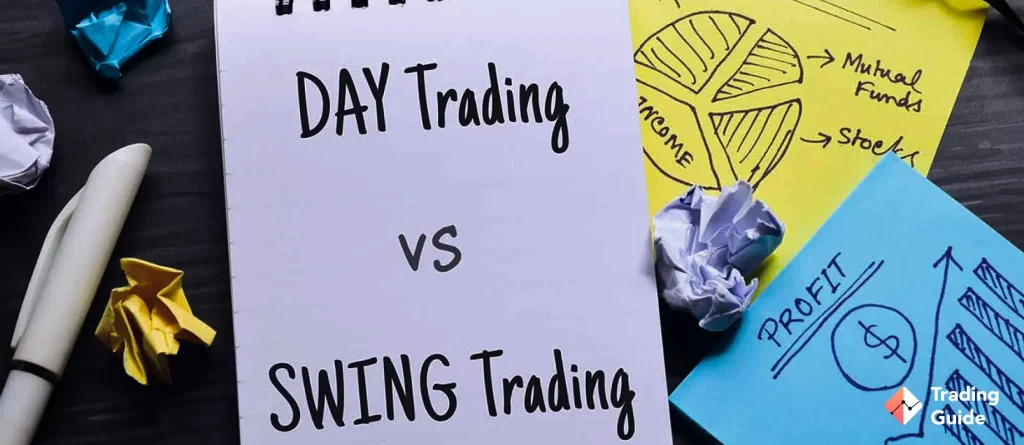Do you want to learn how day trading works and try your luck in the financial markets? Then, keep reading our guide to learn more.
Day trading can be a lucrative investment venture if you know how it is conducted. But, like other forms of trade, it is risky. That is why you need all the requisite strategies up your sleeve if you intend on succeeding in this venture.
As a beginner, you may fear the stringent regulations attached to day trading. The expiry dates are what makes it a more challenging choice of trade. However, you should also understand that the more risky a trade is, the higher the profits if you manage to make the right moves.
Our ultimate guide is meant to guide you through day trading. Hopefully, at the end of it, you will be in a better position to day trade and make good profits. We will also guide you through day trading strategies and risk management elements that help minimise the number of losses, if any. So, without much further ado, let’s get into it.
What is Day Trading?

Like the name says, day trading involves buying and selling financial instruments within a single day. Most traders refer to day trading as intraday trading or short-term trading. It can either be conducted one or multiple times, provided that you get to close all your open positions on that same day.
A well-thought-out strategy can help you manage day trading. It involves small price movements, which can either work in your favour or against. To day trade in any geographical region, a reliable day trading broker goes a long way.
Note that there are many of these brokers in the financial market. Therefore as much as finding them can be like looking for a needle in a haystack, there are various elements that make them legitimate. This includes regulations, meaning that their activities should be overseen by tier-one financial authorities.
Day Trading Strategies
Day traders have various day trading securities to choose from, ranging from CFDs and ETFs to options and futures. Note that day trading allows you to open positions under specific market criteria. Therefore, before you take a plunge on the day trading pool, make sure that you understand which markets you will benefit from.
Volatility and liquidity are essential elements of day trading markets. Volatility will measure market movements variations, whereas liquidity is the ease to which securities can be turned into ready cash without having an effect on market prices. Understanding these two day trading elements is what helps you manage your activities successfully.
Day trading strategies differ from long-term to short-term. You need to be keener with your day trading activities and expect that markets can suddenly become volatile. When this happens, short-term strategies can be the best to manage the situation.
With that being said, here are the basic day trading strategies to get you off to a good start.
Scalping Strategy
Scalp trading strategy is one of the most commonly used strategies in day trading. With this strategy, you can gain small profits with the minimal price changes that occur during a live trade. Here, scalpers hope that the small profits will keep on accumulating, thereby bringing about good earnings.
Scalping is a risky strategy, though it is exciting at the same time if you understand how it benefits your trade. It is mainly applied in forex, stocks, and CFD trading, with quantity as its primary driving force.
Note that you need to have a stringent exit strategy because one single loss could make you lose the entire small profits that you have gained in the process.
Momentum Strategy
Momentum is a popular and beginner-friendly strategy that involves acting on news sources and finding the trending moves that will benefit your activity. With this strategy, traders buy day trading securities that their prices are rising. They will then be able to sell those securities when their prices have reached their peak.
Momentum strategy works with volatility whereby you get to take advantage of the buying opportunities that favour your trades in the short-term rising prices.
To effectively apply the momentum strategy, you should identify the strength of a price trend in a given direction. This way, you will open a position and wait for the price to lose its strength before closing it.
Trend-following Strategy
Trend-following strategy, also known as trend trading, is also a popular day trading strategy. It involves finding a trend that was previously created and following it. Once you feel that the bullish or bearish trend is ending, you can short it and gain profits while still favouring your trade.
Trend trading is also risky, and we can advise you to use trend indicators such as moving averages, Bollinger bands, and stochastic oscillators as a fundamental approach to this strategy. It is applied in all security assets, including currencies, stocks, ETFs, and more.
Breakout Strategy
The breakout strategy ensures that you never miss a move in a market where prices are strongly moving in a particular direction. With this strategy, you will identify the level at which you expect a price to break through and take advantage of it to make good profits. Simply put, traders can buy or sell an asset when a market is near its extreme high or low.
You need a defined trading plan to manage a breakout strategy effectively. This is because of the quick price movements that are brought about after a specific asset price reaches a breakout point. If you manage to execute this strategy correctly, it reduces the trading risks and brings about good returns.
Mean-Reversion Strategy
The mean-reversion strategy is based on the theory that although prices tend to fluctuate, they will always return to a specific average level. Traders use this strategy to make profits when an asset’s prices return to the average level.
For instance, when there is an upward trend and prices are moving above the average level, you can take advantage of the buying opportunity as soon as the prices start returning to the average level.
This also applies in a downward trend whereby prices are reducing beyond the average leverage. Here, traders can benefit from the trend as soon as the prices start rising again to the average level.
How to Day Trade

Like mentioned earlier, day trading requires your complete commitment because of the short-term volatility that creates an opportunity to make profits. As a beginner, you first need to learn how to day trade before you begin to invest your hard-earned cash.
You also need a suitable day trading broker to connect you to various financial markets and try your luck. In addition, always arm yourself with day trading strategies, including risk management controls that will help you reduce the number of losses you are likely to incur.
That being said, below are the steps that you need to follow when day trading.
- Learn day trading: It is important to note that you should first be knowledgeable about day trading to have a chance at being a successful day trader. You do not want to start venturing into an activity that you barely have little knowledge about and experience challenges along the way.
- Choose a day trading broker: With so many brokers in the financial markets, you should learn how to identify a suitable broker for your trading needs. Consider factors like credibility, assets offered, trading platform, UK trading apps and more.
- Create a day trading account: Once you believe you are knowledgeable enough, it’s time to create a day trading account. You can start by testing a broker using its demo account and confirm that its offerings align with your trade needs. Once you are familiar with how the broker works, sign up for the real trading account and get the ball rolling.
- Choose your preferred asset: The broker you choose should host your preferred day trading assets. However, most brokers have limited assets, so this is not a factor you would wish to overlook.
- Open a position: At this point, you should decide whether you want to buy or sell an asset depending on the direction of price movements. Determine the entry and exit points of your trade and start monitoring how it works out.
- Stay abreast with trending news: Economic events and significant market price news can impact your trades, especially if you are day trading stocks or forex. Therefore, staying up to date with the news will help you make the right moves at the right time to reduce any losses.
- Manage the risks: If your trade is affected in any way and starts to move against you, risk management controls like a stop-loss order can save the day. You can use the stop-loss order to close an open position, thereby mitigating any loss.
Read about the best trading platforms in the UK in our other article.
Day Trading Tips
As you embark on the day trading venture, note that you will not just need a day trading broker. You also need to have a budget and stick to it to avoid digging deep into your nest egg. In addition, you also need the necessary equipment like a computer for trading, mobile device, and a stable internet connection.
Knowing when to day trade is equally essential. That said, below are a few day trading tips that will help guide you in the right direction as you start this trading venture.
Stick to Your Rules
Do not let your emotions and other traders’ opinions affect your trading strategy. Instead, focus on your plan for that trade and act fast on any arising opportunities. Discipline is vital, and instead of chasing profits, which is equally essential, it is always advisable to stick to your plan. You never know how the market plays along in the long run.
Have a Budget
Whether you plan to trade long-term or short-term, having a budget before venturing into day trading is crucial. Before you open a position, you should invest the amount you are comfortable losing in case you do not make a profit. This is also one way of managing your emotions.
Never Forget to Mitigate Trading Risks
Before you open any position, you should apply the stop-loss order. This is like your trading insurance that will help you reduce the amount of loss you might incur. Knowing where to place stop-loss orders should become your habit because losses come by once in a while.
Dedicate Time
Day trading requires total commitment, and so you must create time to monitor the markets and take advantage of any arising opportunities. You cannot have minimal time if you want to day trade since an opportunity can arise any time, even during trading hours, and you need to be there to move fast.
Start Small
We usually advise our readers to start trading with small amounts of money. Do not go into trading with lots of cash to invest, expecting that the returns will increase. Instead, ask yourself, what if you lose? Are you willing to lose all the capital that you have put into a trade?
Starting with a small capital is a safe option, and you can continue adding to the amount as you expand your trading skills. The most critical element in day trading is knowledge then the rest will follow.
Pros and Cons of Day Trading
Day trading lets you open and close a position within the same day. For this reason, it is essential that you stay alert with the market trends and know when to close open and close a position to benefit.
Most traders will open a position for a few minutes so that they can benefit quickly and hopefully open another before the day ends. Because of the strict day trading rules, below are the pros and cons that come with day trading.
- Day trading does not have an overnight risk, meaning that no open positions will be left overnight.
- Because day trading involves opening and closing a position within a few minutes or hours, minimal risks are involved compared to long-term trading activity.
- Day trading is flexible since you can open and close a limited number of positions within a day. This allows you to trade any time you see fit until you achieve your objective or are closed out.
- You can trade multiple times within a day in various financial markets, whether local or international.
- Day trading can be costly, especially if you plan to open multiple positions within a day.
- Since day trading depends on market price movement, traders tend to lose whenever there is limited upward or downward movement.
Swing Trading vs Day Trading

Both day trading and swing trading are defined by a timeframe where financial assets are bought, held, and sold for profits. So, what differentiates the two? Read along.
Swing trading involves opening a position and holding onto it for a couple of days or weeks. Unlike day trading, it captures the overall portion of a more significant market trend. For example, most swing traders use CFDs to speculate on the increasing and reducing prices of financial assets. This means that they will open a position if they believe an asset’s value will rise or fall.
The good thing about swing trading is that it can magnify your profits if the market trend favours your activity. However, in case the markets go against you, the losses will also be huge.
Day trading, on the other hand, is opening and closing a position within a day. Here, traders can magnify their earnings through small profits that accumulate.
That being said, here are the main differences between swing trading and day trading.
- Swing trading allows you to open a position and leave it open for days or weeks, whereas day trading will only let you open multiple positions and close all of them within a single day.
- Since swing trading allows you to hold on to an open position for days, overnight fees are applied. In contrast, day trading does not incur overnight charges since all positions should be closed within a day.
- You do not need more time to swing trade since once you open a position, all you have to do is monitor your trades until it closes at the set time or day. However, as for day trading, you must dedicate more time since your open positions can only last for minutes or hours within a day.
- With swing trading, you can open fewer positions and expect more significant gains. Unfortunately, this also means that you may incur more significant losses if it occurs. When it comes to day trading, you are free to open more positions, which in return brings about smaller profits and losses, if any.
Bottom Line
Most day traders rely on day trading signals and price charts to improve their strategy. Remember that a good day trading strategy focuses on maximising the profits rather than the losses. Therefore, make sure to fully utilise the available strategies and stick to your plan.
No matter what type of day trading strategy you choose to use, do not forget to always mitigate any potential loss. For example, applying stop-loss orders is a reasonable risk management control in day trading for dummies. This, combined with day trading knowledge, will increase your potential of making profits.
Lastly, consider the type of day trading broker you choose. For beginners, such brokers should be regulated in your geographical area and have a user-friendly platform. They should also have a wide array of offerings including, financial securities, research tools, and learning material that will improve your trading skills.




Having placed over 1000 trades, I know firsthand that having a reliable day trading platform stocked with the trading tools you need is crucial to success. In my opinion, the best day trading platforms are TD Ameritrade and Interactive Brokers.